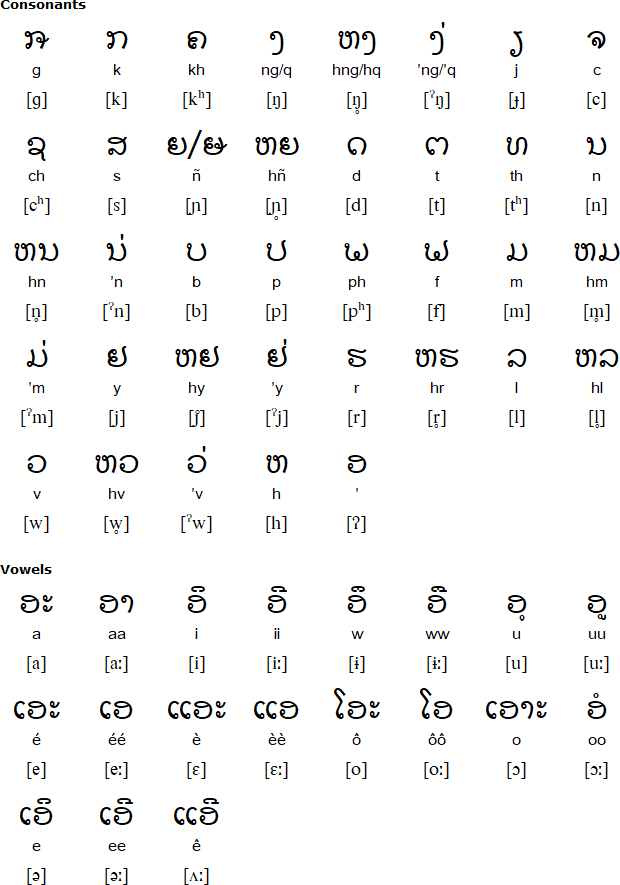Khmu is a member of the Khmuic branch of the Austroasiatic language family. It is spoken mainly in northern Laos, and also in nearby parts of Vietnam, Thailand and China. In 2015 there were 708,000 speakers of Khmu in Laos. There were 72,900 speakers in Vietnam in 2009, 7,000 speakers in China in 2010, 6,250 speakers in Thailand in 2007, and in 2010 there were about 8,000 speakers of Khmu in the USA.
There are two groups of Khmu dialects: Western and Eastern. Dialects spoken in neighbouring areas are more or less mutually intelligble, however speakers of more distant dialects may have difficulties communicating with each other. The written language is based on Eastern dialects.
Khmu was first documented by French scholars in the late 19th century. Other scholars have studied the language since the 1950s. Ways to write it with Latin and Lao alphabets have been developed. The Lao script is currently used when teaching the language in schools in Laos.

Download an alphabet chart for Khmu (Excel)
Corrections provided by Michael Peter Füstumum
Kmhmuʼ meh sqmeh déʼ môôy phav daʼpaʼ-théét Laav(meh phav jwa Mon-Kmer) yoʼ ge chrôʼ prʼôôm hrloʼ Mon-Kmer. Kmhmuʼ meh phav sndraan déʼ pa-théét Laav paʼ no goʼ meh phav hnam thi péʼ(saam)daʼ mwaq Laav. Rqgèʼ taam kaan sook vwl hmméʼ lwaq phav daʼ paʼ-théét Laav déʼ thaan Laurent Chazee daʼ pi 1991, ge bwp sah Kmhmuʼ meh 32% déʼ paʼ-sa-sôn paʼ lôôc, ah paʼ-maan 1.4 laan gôn.Baq hnooq lav sah daʼ paʼ-maan pi 1230, ah môôy phav sqmeh phav Laav no duʼcaak luaq tal déʼ paʼ-théét Ciin hôôc no guut yat daʼ ptéʼ k`niʼ kʼeey paʼ-théét Laav. No guut rèèp `mèèp gôn bè sek bè tqmaʼ(broom Kmhmuʼ) hôôc no rac Koon Kmhmuʼ gôn hmaq déʼ ptéʼgniʼduʼ dar prsoor yat daʼ môk môk jôq hrôq jruʼ, gôn gmeʼ duʼ am than no goʼ grwp moot tèèq khooy tèè`maav. Kmhmuʼ daq keet meh phav ñèʼ, yat slé yat prsoor, yat jaʼ hrloʼ riñ hrloʼ cleen,keet gôn briaq srʼoh briaq hmbriʼ.Yar niʼ Kmhmuʼ daq am bwan lap sit meh paʼsa-sôn Laav kiñ hmwan briaq. Taq qwan niʼ yoh koon Kmhmuʼ daq yat hmwan phav baq pooy baq trvayh,baq pnmeh phav yoʼ ge hndéʼ lut phav Laav yoʼ ge pôk-khooq paʼ-théét.Hôôc no goʼtaq sqmeh Kmhmuʼ`mèèp paʼ-maat maak sqmeh hmwan: Kha, Laav-theq, Laav-Kaaq, Thay-hai paʼ khaʼ-muʼ. Kha meh sqmeh jèʼ Laav lav paʼ-maat Kmhmuʼhmwan iʼ méc sqmeh Nigrô nam baq joq kʼeey jeʼ hiaq daʼ Amérika.
Khmuʼ is the name of an ethnic group in Laos (an ethnic of the Mon-Khmer group) who speak the Mon-Khmer language. They are the native people of the country of Laos and are one of the three largest ethnic groups in Laos. According to the latest research of the Laos ethnic group by Laurent Chazee in 1991, the Khmuʼ people represent 32% of the total population, about 1.4 million. In the 13th century, about the year 1230, an ethnic group called the Lao, immigrated from the southern portion of China into the territory now known as Laos. They came and invaded the territory as conquerors, driving some of the native inhabitants into the remote mountainous areas of their land and enslaved the rest of them. These highland outcast, known as the Khmuʼ maintained their ethnic distinctiveness and lived as a secluded minority, far away from civilization.
Source: http://www.khmuoc.org/KhmuHistory.aspx
Information about the Khmu language
https://en.wikipedia.org/wiki/Khmu_language
https://www.ethnologue.com/language/kjg
https://www.unicode.org/L2/L2010/10335r-n3893r.pdf
http://www.khmuoc.org/TableOfContent.aspx
https://www.everyculture.com/wc/Japan-to-Mali/Kammu.html
Page last modified: 18.06.25
[top]
You can support this site by Buying Me A Coffee, and if you like what you see on this page, you can use the buttons below to share it with people you know.

If you like this site and find it useful, you can support it by making a donation via PayPal or Patreon, or by contributing in other ways. Omniglot is how I make my living.
Note: all links on this site to Amazon.com, Amazon.co.uk
and Amazon.fr
are affiliate links. This means I earn a commission if you click on any of them and buy something. So by clicking on these links you can help to support this site.
[top]